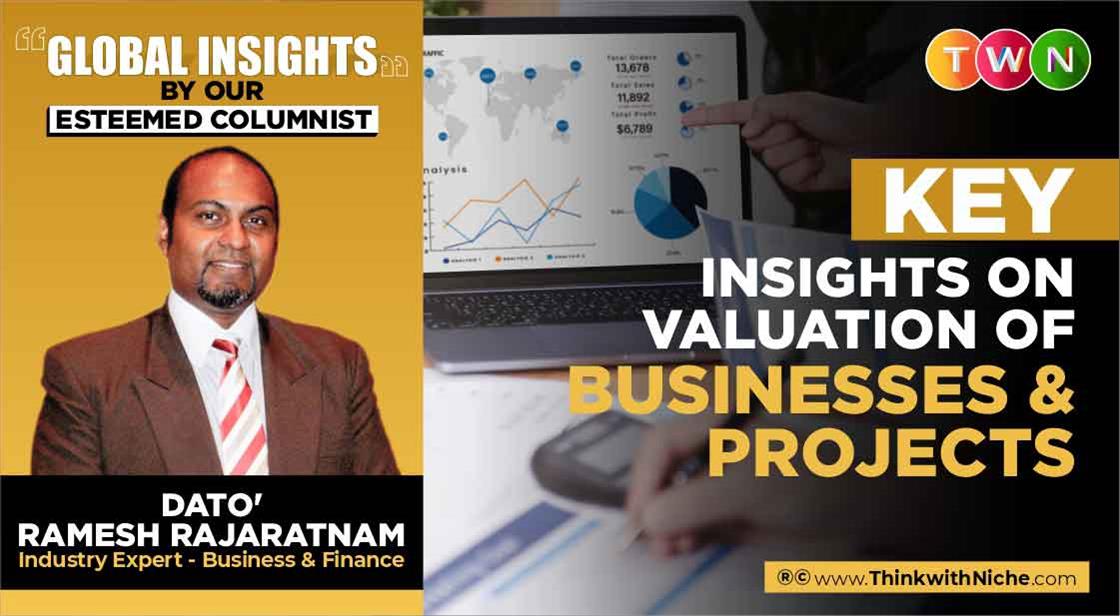Key Insights on Valuation of Businesses & Projects

Blog Post
Often in the course of my official and non-official capacity, I am asked about the valuation of businesses and projects. Often, I am amused by the terms that we accountants use to calculate “Value” and consequently, determine “Valuation.” Read on to explore key insights from my experience of this concept. #TWN
After almost 20 years, I must admit, at the risk of losing my clientele, that I too am completely bewildered by the myriad of methodologies and terms applied in Calculating Value: WACC, DCF, EBITDA, PER, NBV, NTA, MV, PBV, etc. Now and then, someone comes up with a new way (or acronym) of Calculating Value, but how many of us really understand these concepts?
What is Value? and how does one decide on Value Ludwig von Mises, one of the most influential capitalists of our times described it as: “Value is not intrinsic; it is not in things. It is within us; it is how man reacts to the conditions of his environment. Ultimate decisions, the valuations, and the choosing of ends are beyond the scope of any science.”
If Mises could say that, then why do we, presumably lesser-enlightened beings, try to even put a scientific or mathematical formula to assess Value. But I guess, if we do not agree on a common method, then there is no end to determining Value as you and I know: A couple of years ago, a prospective client told me that based on his accountant’s calculations, applying the Discounted Cash Flow (DCF) method, the RM 20 mil he was considering paying (borrowing partly) for an acquisition would give him a payback period of about 6 years on his cost of investment, better than the industry’s average of 7 years: Prima facie, this appeared to be a good deal? I told him to forget the deal if that was the expected return... I’ll tell you why later in this article.
Given that an accountant’s work is almost as glamorous as a pilot’s, especially in a single’s bar. In layman’s terms, I shall now attempt to explain below the several easier common methods that are used to value companies and highlight some personal observations in each of these methods. Because doubting these well-established methods will be considered sacrilegious, I’ll task you with the questions, and you can be the judge?
1. Market Value (MV)
Where the shares of the company are listed, in essence, the MV is simple to determine: Multiply the quoted share price of the company by the number of issued shares. This reflects the price that the “market” is prepared to pay for the shares of the company, at specific intervals in time.
This valuation is influenced by the condition of the share market, the industry-specific issues and opportunities that are seen for the company, and naturally, investor confidence in the market as a whole. In mature markets, the price should reflect the investors’ sentiment of the ability of management to deliver a decent return on the assets of the company. It is indeed arguably true that the share price may also reflect the synergies that an expansion (acquisitions, new lines, personnel, etc.) may bring – to an extent, forecasting up Madam Zorra’s alley.
However, in more versatile markets, the fact that the Chairman went to China to treat his inflamed piles may easily be spun by the doctors to give the supposition of the company obtaining a pharmaceutical concession in the land of the Billion. The share price then shoots up from a mere 16 sen to RM 4 on an astronomical run – a Market Capitalization boost of 24 times. Question 1: Fair MV?
In most cases, the available ‘float’ (i.e. the shares that are actually traded freely in the market as opposed to the amounts controlled, and hence not traded freely, by smaller groups of shareholders) is usually in the region of 15% to 25% of the total issued shares of the company. It means that the “market value” of the company is, ironically, controlled by the market price of the smaller float rather than larger untraded shares. In a hypothetical situation, someone gaining control of a third of the free float of, say, 15% of Company X and having the cooperation (not to sell their shares when the price is trading up) of the major shareholders of Company X can actually determine the market value of Company X by chasing up the ‘market price’ of Company X’s shares. So a fairly dormant Company X, whose 40 million (float of 6 million) shares were quoted at RM 10 on day 1, would have had a market capitalization of RM 400 million. Then comes along Mr. P, who buys up 2 million shares in Company X from the market – naturally, because of the small free float, the share price will move up, possibly by at least 33% (provided that the controlling shareholders do not sell) and the price of Company X’s share closes at RM 13, an increase in Company X’s ‘market value’ from RM 400 million to RM 520 million in 8 trading hours? And this phenomenal MV increase arose out of purchasing a mere 2 million shares (5% of the paid-up capital) – who then, one may ask, controls the MV? Of course, there are laws to prevent this. Question 2: Fair MV?
No matter how sophisticated the markets are, never though, does the Market price ever reflect the ‘break-up value’ of the whole company: The sum of the units are almost always, smaller than the individual units if separately listed; usually on the excuse that the yield potential and risk profile of the spun-off entities are different, etc. Really? In a ‘spin off’ situation, the Board (let’s face it, a few independents may be inducted to provide governance, and protection for the new minority), Bankers, and virtually all stakeholders would remain the same as the pre-spin-off entity: Just look at the recent spin-offs locally, what’s the real difference? It is almost as if, by consolidating the group’s operations for better management of its resources, the market penalizes the company for the ‘consolidation’ efficiency? Question 3: Fair MV?
The ability to spin off mediocre units of a company in a bullish market has created false performance marks for many a CEO in the developed economies. It’s only a matter of time (I am not saying that it hasn’t been done yet) that such ‘wealth unlocking’ mechanisms are imported and rode on liberally, in our market: ENRON was a classic example where presumably underperforming units were spun off into Special Purpose Vehicles (SPV) and traded in various forms. Think about this: If pursued, a debt of RM 1 billion can be taken off the Balance Sheet, injected into an SPV, and by way of legally crafted investment means, brought back into the Balance Sheet as an investment at, voila! Market Value? For the accountant in you, it’s not hard to pass these Net Book Entries:
On disposal of debt to the SPV:
Dr. Balance Sheet- Loan from Banks RM 1 Billion
Cr. Balance Sheet- Due to Investment Banks (IB) RM 1 Billion
The IB then flogs this quality debt at an equitized value of RM 2 Billion. The company buys this debt paper at the MV of RM 2 Billion:
Dr. Balance Sheet- Investment in SPV RM 2 Billion
Cr. Balance Sheet- Due to Investment Banks (IB) RM 2 Billion
The IB passes back the ‘profits’ of equitizing to the company:
Dr. Balance Sheet- Due to Investment Banks (IB) RM 1 Billion
Cr. Profit & Loss- Gain on ‘disposal’ RM 1 Billion
The Net Effect: A (paper) gain of RM 1 billion due to spinning off the loan into an SPV. The higher the leverage out and circuitry of the SPV by the friendly IB, the higher the propensity for flogging the equitized price: a ‘win-win’ for both the company and the IB. When this scheme fails, as it inevitably would due to the gearing up effect in the Balance Sheet, the masterminds would have divvied up the ‘profits’ and long disappeared. Accounting policies as they stood then would have allowed this. Question 4: Fair MV?
2. Market Value Added (MVA)
At this point, it is worth bringing to attention a related MV method of valuation - Market Value Added (MVA): MVA is a cumulative measure of wealth created by the company for its investors. It is calculated by comparing the market value of a company's total invested capital with its book value (adjusted for equity equivalents) and can be summarized as follows:
MVA = [(shares outstanding x share price) + (market value of debt)] - book value of total capital invested
In layman’s terms, the MVA represents the difference between what investors could take out of a company and the total capital provided by shareholders and lenders, and it is thus a measure of management's success in “adding value” to the cash provided by the company's investors (Stern & Hahn said something similar in 1994).
However, this is where I have a problem with the practicality of the MVA concept. In substance, the theory states that companies (whose EVA is regularly positive) should see “a growing MVA, as investors' confidence grows in the company's ability to consistently deliver a return above the required risk-adjusted rate.” Bull!
Question 5: Because book value is almost always equal to par value, have you EVA considered that poorly managed (as a result, highly leveraged) but artfully promoted companies would command a laughable premium if such a sophisticated business valuation theorem was applied to explain their rallying price?
3. Net Book Value (NBV)
Total assets minus total liabilities in the company: Simple enough, right? Wrong – while ‘penalizing’ the business for all its’ known and estimated potential liabilities, this method blatantly ignores the future returns the assets can produce and is calculated using staid ( yes ) accounting practices that do not reflect the real worth of the business to someone who may buy it as a going concern. In a more drastic variation, the NBV could be further reduced by eliminating ‘intangible’ assets (e.g. licenses, brand names) to arrive at the Net Tangible Asset (NTA) position of the business. Question 6: Will Coca-Cola ever accept that the name ‘Coke’ isn’t it after all?
On the flip side, there is a need for pragmatism; if I paid RM 10 million for a business with an NBV of RM 10 million, what is the net benefit of my doing the deal? Look, I might as well start from scratch to build such a business (if practical) – at a cost that I’d dare say, less. I would therefore expect to buy the business at a cost lower than RM 10 million, to cover at a minimum, my financing cost – versus his sweat equity. Of course, if I were to buy it from my brother, out of love, to continue the family tradition in a business that I have been involved in together with the rest of my family, then maybe I would not feel so bad because there is a non-commercial element in the valuation: The thinking behind the recent bank consolidation perhaps?
Over the years, I’ve noticed some interesting phenomena in NBV based deals were simply put, caveat emptor prevailed in favor of the Vendor, regardless of the pre-acquisition Financial, Legal, Commercial, Technical, and Tax due diligence by the Buyer:
-
where the bulk of the assets sitting in the Target was originally purchased from the Vendor’s private companies (especially in cases where a foreign parent sells machinery to its Malaysian subsidiary, the Target), and in such situations, the Book Value to the Target was simply the acquisition cost of those assets. Naturally, if the parent had ‘passed on’ some costs (known as transfer pricing) by inflating the cost of the asset it sold to Target, being in a position of control, the parent would have instructed Target to account for the assets acquired at the ‘inflated’ cost. In the absence of noticeably blatant inflation, the audited accounts would have treated the acquisition cost as Book Value. Question 7: Now would you consider this audited Book Value as a ‘fair’ Book Value, from the perspective of the Buyer?
-
where the bulk of the specialized assets sitting in the Target was originally purchased from the Vendor’s private companies, and in such situations, the Book Value to the Target was simply the acquisition cost of the assets (see above). Naturally, if the Vendor had understated some costs (again, transfer pricing) by deflating the cost of the asset he sold to Target, being in a position of control, the Vendor would have instructed Target to account for the assets acquired at the ‘deflated’ cost. In the absence of a noticeable understatement, the audited accounts would have treated the acquired cost as Book Value. In the post disposal period, when the Buyer seeks to purchase the same specialized machinery from the Vendor (because the Vendor is the sole supplier), the Buyer would have to pay, say 50% more than the ‘inherited’ Book Value. Consequently, his cost of production goes up by, say 20%, due to the revised direct manufacturing costs arising from the higher-priced machinery’s depreciation. As a result, his business may become unprofitable or generate fewer cash flows than originally anticipated. Question 8: From the perspective of the Buyer, hasn’t he been whacked by the audited Book Value?
-
Taxes (both current and deferred) can wreak havoc on Book Values in an M&A scenario, where the Vendor may enjoy certain tax benefits on specific assets while the Buyer may not, or, when the reorganization of the business for the purchase by Buyer, results in the Buyer acquiring the same assets with a different tax base than that recorded, at Book Value, by the Vendor. In both scenarios, his business may become unprofitable or generate fewer cash flows than originally anticipated as a result of the loss (or reduced) tax benefits on the assets inherited. Question 9: Once again, while the audited ‘Book Value’ is the same, the real cash generation Value is different for the Buyer?
-
Fair value accounting – MASB 21 (yes, another complex accounting standard that we bean-counters formulated so that we can create more work for ourselves….) requires the Buyer to account for all assets and liabilities acquired at ‘fair value’, even if the Vendor originally did not account for them as such in his audited accounts. Question10: Do you mean the Vendor was being ‘unfair to himself’ by not recording them fairly previously; hey, it isn’t fair to the Buyer now to have to take a write-down on a previously audited number?
4. DCF
The fun begins now. DFC uses the future free cash flows of the company (after all liabilities and estimated costs have been covered) discounted by the company's weighted average cost of capital (‘WACC’ - the average cost of all the capital used in the business, including debt and equity), plus a risk factor measured by ‘Beta.’ Beta is a moderation adjustment that uses historic data to measure the sensitivity of the company's cash flows, e.g. through cyclical routines. It means that companies in highly cyclical businesses or with fluctuating cash flows will have a high Beta (hence, a higher risk-weighted discount) to reflect the volatility of their cash flow. The DCF method appears to be, on the face of it, a persuasive valuation tool because it focuses on the cash generation potential of the company. (OK, really, DCF: If you were to invest RM 2 million today, you would expect to get your original invested capital plus a premium back, by way of yields from your investment, within a reasonable period, taking into account inflation and interest rates).
A fundamental assumption in the DCF Formula is that the annual cash flows will be distributed to the shareholders in ‘weightage’ to their holdings. However, in the real world, in leveraged acquisitions (i.e., when you buy a Target using your own money plus Other People’s Money (OPM), the Bank will have priority over common shareholders, through what we call a process of subordination of debts. Interest (or profit) and principal will always be paid to the Banks before dividends are paid to the common shareholders. The banks may also insist on several other cash flow maintenance covenants that will defer dividend payments to the shareholders. Consequently, the common shareholders’ cash flow is actually delayed rather than annually distributed as the DCF formula presupposes: In reality, the actual return to the common shareholder is much lower than the one used in calculating WACC, solely due to the subordination of cash flow payments. Simply put, the traditional WACC formula overvalues an investment because the subordination impacts are not considered. Question 11: And, the Beta – after 20 years, I can safely say that it is almost impossible to measure- to test, ask any senior accountant how to calculate Beta?
As for my then prospective client’s RM 20 million question at the start of this article: If the DCF based value was about market average, why bother. Surely he should expect to get at least 25% more than what the market average was given his sweat equity factor, and the fundamental error in the WACC formula as explained above? And yes, he is now my friend and a very grateful client!
5. Price-Earning Ratio (PER)
PER is simply the number of times the share is priced at compared to the net earnings of the company; meaning that all things being equal, a company with a PER of 5 is, a better buy than one with a PER of 7 because it takes an investor 2 years less to recover her investment from the yields of the original buy.
Due to its simplicity, this is probably the most popular evaluation method in Malaysia (notwithstanding its’ many inherent weaknesses). Listed companies are benchmarked against their peers’ PER to assess their attractiveness. For non-listed companies wishing to apply the PER method, a comparable quoted company/industry sector should be selected. The main difficulty lies in the assessment of ‘comparable’ company data because differences in audit quality (it happens) and accounting policies (e.g. treatment of goodwill, deferred taxes, etc.) tend to skewer the PER of the selected companies. Many professionals usually spend much time streamlining the selected companies’ results to assess a reasonable PER and as a result, open their work to needless scrutiny, especially if the investment recommendation subsequently turned out to be bad.
6. Pay Per Page (PPP)
Oh yes. It would be completely remiss if I did not mention one of the more novel methods of valuation: PPP. The PPP methodology seeks to determine the value of, usually, a dot-com portal/vortal by ascribing a $ value to the number of times a page from the website is viewed by normal mortals. The basic premise is that there is promotional value to be gained by the number of times the website is ‘hit’ by surfers. Don’t laugh but in the hey-days of the ‘dot.con’ era, some prominent investment houses in the US were not too averse to subscribing to this novel method of flogging the stock with their clients.
I do not wish to argue the (de)merits of the PPP but suffice it to say that based on my (et tu?) net surfing activity (or should I say proclivity), if the PPP theorem held, I would have contributed substantially towards making billionaires out of many interesting website owners. Inevitably then, Question 12: 2B or not 2B?
What then is a good valuation method? Oh, well, that’s a future article, I suppose. I will, however, leave you with the following thought:
It is hard to imagine a more stupid or more dangerous way of making decisions than by putting those decisions in the hands of people who pay no price for being wrong.
- (hey, I didn’t say this; Thomas Sowell did!)
Dato' Ramesh Rajaratnam is a Chartered Accountant (MIA) and a Certified Public Accountant (MICPA). He is a member of the Corporate Finance (CF) faculty of the Institute of Chartered Accountants in England and Wales (ICAEW) and a Fellow of the Institute of Chartered Accountants in Australia. His alliance with ThinkWithNiche is on an honorary basis. The references, facts, and figures that he uses in his content are by virtue of his experience and opinion. ThinkWithNiche holds no part in structuring his content.
Dato' Ramesh Rajaratnam has been kind enough to be One of Our Mentors and accepted to be An Esteemed Columnist with Think With Niche Platform and share his years of experience and knowledge with our Users/ Readers as Knowledge.
In case you find any discrepancy in his articles, you can reach us at Editor@thinkwithniche.com
Here’s the link to the LinkedIn Profile of Dato' Ramesh Rajaratnam:
https://www.linkedin.com/in/dato-ramesh-rajaratnam-25a5a86/
This article is also published on Dato' Ramesh Rajaratnam's Personal Blog Page:
https://r-tickles.blogspot.com/2022/01/valuation-in-m-scenarios-whacked-by.html
If you enjoyed reading this article, explore more from Our Industry Experts...
CLICK HERE TO READ- Three Inspirational Success Stories of Young Entrepreneurs
You May Like
EDITOR’S CHOICE














